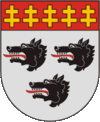 Alternate names: Marcinkonys, Marcinkańce, Mareinkonys, Martsinkantse, Martsinkantsy, Martsinkonis. 54°04' N 24°23' E, 56.8 miles SW of Vilnius. [March 2009]
Alternate names: Marcinkonys, Marcinkańce, Mareinkonys, Martsinkantse, Martsinkantsy, Martsinkonis. 54°04' N 24°23' E, 56.8 miles SW of Vilnius. [March 2009]
This village in Varėna district SE of Merkinė is the administrative center of the Dzūkija National Park and Čepkeliai Marsh. 2001 census: 765 residents. The settlement existed since 1637, when it was a camp of foresters. It began growing after completion of the train station (Warsaw - Saint Petersburg Railway) in 1864. During the Holocaust, the village had the Marcinkonys Ghetto, improvised forest huts . A few Jews escaped during the liquidation of the ghetto and managed to survive the war.
Mass Grave: Before WWII, the Lithuanians and the Jews enjoyed good relations. Locals recalled the Jews as particularly just people who would sell food and other goods to the Lithuanians on loan paid back in up to a year, when they had money. The 1.5 ha Marcinkonys Ghetto surrounded with barber wire set up at the end of 1941 was near Marcinkonys railroad station. The Jews from Marcinkonys, Rudnia, Kabeliai, and most probably a part of Varena's Jews were crammed into the ghetto. The number reached several hundred. After the war, residents of Marcinkonys recalled Dr. Leitman with respect. He treated poor people free of charge. During the German occupation, when Marcinkonys was part of Grodno guberniya (Belarus), when Leitman and his family were driven to the ghetto, several Marcinkonys residents asked them to free the Leitmans, but to no avail. Later, somebody helped the Leitmans escape the Ghetto and hide. When a traitor informed, the doctor's family was arrested and shot. German policemen, German customs officers, and foresters (29 men). The Germans surrounded the Ghetto at 5 a.m. before the operation, they were instructed to shoot those who tried escape or to hide Jews. When the German got to the ghetto, they informed the Judenrat leaders about the forthcoming evacuation of the ghetto. All were to gather with their belongings in the ghetto square at 8 a.m. About 80 Jews who complied were told to see if other Jews remained in the buildings. When about 150 Jews lined up in the square, suddenly, they started running, some to the forest through the damaged fence and others back into ghetto buildings. The Germans shot about 90 Jewish men, women and children. Later, they searched from door to door for Jews in hiding. When found, they were shot on the spot. The Germans found five secret bunkers. The Jews refused to leave so the policemen destroyed the bunkers with grenades. 132 Jews were killed at the time of liquidation of the Ghetto while about 200 (mainly young men) escaped to the nearby forest and joined Soviet partisans. Marcinkonys ghetto was liquidated on November 2, 1941 and its prisoners put on a train to an unidentified location (?concentration camp). The murdered Jews were buried in the forest. The memorial monument says that "on 3 November 1942 the Nazi executioners and local collaborators killed over 600 Jewish children, women, and men of Marcinkonys", a probably exaggerated number. Attacks by Soviet partisans on Marcinkonys environs increased after the liquidation of the Ghetto. Some of the Jews hiding in the forest were betrayed by locals. Quite 14 men and 7 women Jews who escaped the Ghetto hid close to Musteikos village in forest bunkers). Resident of Musteikos village, Domas Tamulevičius, showed the hideout of the Jews to the Germans, who forced the Jews out of bunkers and shot them dead. However, other villagers brought the Jews food and helped them in other ways (e,g. Janina Averkiene). On June 28 , 1945), an NKVD unit arrived at Musteikos village with surviving Jews from Marcinkonys among them. NKVD arrested and shot 14 men of the village (Tamulevičius among them). Those who helped the Jews under the Nazi occupation were left unharmed. [March 2009]
